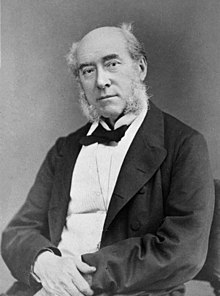William Fergusson
Sir William Fergusson (born March 20, 1808 in Prestonpans , † February 10, 1877 in London ) was a Scottish surgeon.
Life
Fergusson studied at the University of Edinburgh and initially wanted to be a lawyer, which is why he started as an assistant in a legal practice at the age of 15, but then switched to medicine at the age of 17. He was a demonstrator for Robert Knox , was licensed in 1828 and in 1829 a Fellow of the College of Surgeons in Edinburgh. After that he also gave lectures. As with Knox, he spent up to 16 hours a day in the dissecting room. Since Knox received many of his corpses used for dissection by stealing from the dead, a scandal broke out, in which Fergusson was also involved as his assistant. But it didn't do him any lasting damage. In 1831 he became a surgeon at the Royal Dispensary Hospital in Edinburgh and in 1836 at the Royal Informary. He was next to James Syme as the leading surgeon in Scotland. In 1839 he became a professor at King's College London and the recently opened King's College Hospital and also had a private practice. As his reputation continued to grow, he became the Crown Prince's surgeon in 1849, Surgeon-Extraordinary in 1855 and Sergeant-Surgeon of the Queen in 1867. For many years he was considered the leading surgeon in London. In 1861 he was elected to the council of the College of Surgeons, where he became an examiner in 1867 and its president in 1870. In 1870 he resigned from his chair at King's College, but remained Professor of Clinical Surgery and Senior Surgeon. He died of kidney inflammation (Bright's disease).
Act
Ferguson coined the term conservative surgery, which operates as gently as possible and while preserving body parts. He already had forerunners like James Syme, but systematically extended it to small parts of the body. He benefited from his intensive anatomical studies and dissecting practice. In contrast to the controversial Syme, he was reserved and of a friendly nature, was considered humorous and hospitable. Ferguson looked after his students and often helped out as a surgeon for free. He was also an excellent carpenter and craftsman, with which he impressed his teacher Knox, and made and improved some surgical tools himself (for example a device for removing bladder stones through the urethra). He was famous for his speed in operations (he could remove a bladder stone in 30 seconds). That was important at the time because there was no anesthesia yet. That only changed around 1846 with the introduction of ether anesthesia, from which Fergusson also benefited and which made his conservative surgery possible in the first place. He performed over 300 operations on harelip . Fergusson planned every detail of the operation in advance with care for any eventuality. The operations were quick and silent, with he putting on every bandage and plaster himself and leaving as few marks as possible after the operation. He insisted on punctuality and hated wasting time. The obituary in The Lancet of 1877 read : Few men equalled and none probably surpassed him as an operator. (Few came like him as a surgeon and he was probably surpassed by no one) .
Honors and memberships
He was a Fellow of the Royal Society , the Royal Society of Edinburgh and the Royal College of Surgeons of England (member 1840, fellow 1844). In 1859 he became President of the Pathological Society of London for two years. In 1873 he became President of the British Medical Association. In 1875 he received an honorary doctorate (LLD) from the University of Edinburgh. In 1866 he was appointed baron. In 1871 he held the Hunterian Oration.
Private
In 1833 he married the wealthy heiress Helen Ranken, with whom he had two sons and three daughters. He played the violin well and one of his hobbies was fly fishing. Fergusson was also considered a dandy who drove through London in a yellow coach ( called the mustard pot by his students ) with two servants and accompanied by two Dalmatians.
Fonts
- System of Practical Surgery, London, 1842, 5th edition 1870, Archives
- Lectures on the Progress of Anatomy and Surgery during the Present Century, 1867
literature
- Henry Smith: Sir William Fergusson, A biographical sketch, London 1877, Archives
Web links
- Susan Isaac, A practical surgeon: Sir William Fergusson (1808-1877) , Royal College of Surgeons of England (2018)
- Entry in Dictionary of National Biography
- Encyclopedia Britannica 1911
Individual evidence
- ^ Originated from a series of articles for The Lancet
| personal data | |
|---|---|
| SURNAME | Fergusson, William |
| BRIEF DESCRIPTION | Scottish surgeon |
| DATE OF BIRTH | March 20, 1808 |
| PLACE OF BIRTH | Prestonpans |
| DATE OF DEATH | February 10, 1877 |
| Place of death | London |
